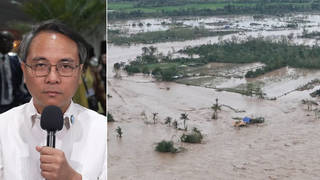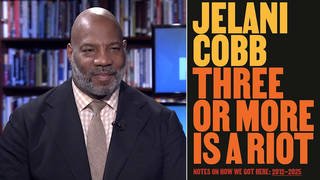
Guests
- Ellen Smithowner and managing editor of Mine Safety and Health News. She has been covering mining-related issues since 1987 and has won numerous journalism awards for her reporting.
Ellen Smith, editor of Mine Safey and Health News, discusses the mine collapse, the weakening of mine safety regulations under President Clinton and President Bush, and the history of the mine’s owner — Murray Energy Corporation. [includes rush transcript]
Transcript
AMY GOODMAN: In Utah, rescuers are still trying to reach six coal miners who have been trapped more than 1,800 feet underground for the past eight days. There has been no sign of the six men since the Crandall Canyon Mine in central Utah caved in last week. Bob Murray, head of Murray Energy Corporation and co-owner of the mine, spoke at a news conference yesterday in the nearby town of Huntington.
BOB MURRAY: I’m very disappointed to be telling you on the eighth day that we have not found six alive miners. It has been the hope and prayer of all of us. As I’ve said before, the initial concussion of the seismic activity could have killed these minors outright, and they would not have suffered. However, I want to emphasize that there many, many reasons to have hope still. There are many reasons why one would believe that they still may be alive.
AMY GOODMAN: Images from a video camera lowered into the collapsed mine revealed equipment, but no sign of the miners. Officials said they were preparing to drill a third hole deep into the earth in the hopes of finding them.
It’s still unclear what caused the mine to collapse. Bob Murray has insisted it was caused by an earthquake, but seismologists say there was no earthquake and that readings on seismometers actually came from the collapse. One of the four miners who escaped alive said Sunday he didn’t feel or hear a thing as the mountain shook and caved in.
All six trapped miners have been identified by their families. Three of them are Mexican citizens.
Ellen Smith is the owner and managing editor of Mine Safety and Health News. She’s been covering mining-related issues since 1987 and has won numerous journalism awards for her reporting. She joins me now from Rochester, New York. Welcome to Democracy Now!
ELLEN SMITH: Good morning.
AMY GOODMAN: It’s good to have you with us. Can you lay out at this point what you understand has taken place, starting from what the men were doing in the mine when the collapse, when the accident occurred?
ELLEN SMITH: Right. The men were doing something called retreat mining, and it’s, of course, something that Mr. Murray has denied. But they weren’t retreat mining in the sense of cutting away the pillars completely. It’s what we call splitting the pillars, which is taking coal from the remaining pillars. And what two experts believe right now — and that would be Bob Ferriter and Larry Grayson, who are very highly esteemed mining engineers in this industry — they believe that because you had two mined-out sections on either side of where they were cutting their pillars, it was too much stress on the remaining pillars, and so therefore you had the huge bounce or the pillars and ribs gave out.
AMY GOODMAN: What do you mean, Ellen, that this was denied, this kind of mining?
ELLEN SMITH: Mr. Murray has said, “We were not retreat mining.” But, then again, Mr. Murray has also said this was an earthquake. And the U.S. Geological Survey said that they’re 99 percent sure that the seismic readings were from, in fact, the mine caving in and not an earthquake-related seismic event.
AMY GOODMAN: What is Bob Murray’s history? Explain exactly who he is, what he owns.
ELLEN SMITH: You know, Mr. Murray has a fairly checkered history. He’s got 27 mines right now that are working or temporarily idled for one reason or another.
We’ve written about him. He first came to my attention in 1993, and it’s because it was a fairly sad case, where a mine foreman lost his arm in one of Mr. Murray’s underground coal mines, and he bled to death before they could get him to the surface. Now, according to a witness, about a week before this accident occurred, Mr. Murray had said to 40 miners that under no circumstances were they to turn off the beltline, because if you can’t move coal out of the mine, you’re not making money. And he said, “I don’t want that belt turned off unless there’s a man in it.” A week later, there’s a problem on the beltline. A foreman goes to see what’s wrong. He didn’t turn the belt off, and his arm got caught in the conveyer belt and ripped off. I mean, it was a very, very sad case. Now, they weren’t arguing the point of law of what Mr. Murray said, but the point of law was whether or not this foreman was doing repair and maintenance to the belt, where it should have been turned off. And that was really unclear in the case. But what wasn’t disputed was what Mr. Murray said in front of these miners.
He had another mine called KenAmerican Resources, where the supervisors were found guilty of felony Mine Act violations for trying to cover up an accident, lying to investigators, giving advanced warning to the miners underground that mine inspectors were coming in. They would say, “Company’s coming,” and so that way the miners could try to get some of the safety features in place, like the ventilation curtains, up. Putting up ventilation curtains, of course, takes more time when you’re mining. And those, they were found guilty. Now, Mr. Murray, you have to understand, has never been found guilty himself. It’s been supervisors, foremen. But we always say in this industry that safety starts from the top down.
At his Powhatan No. 6 mine he was in big arguments with the Mine Safety and Health Administration officials over problems they had there, over citations he got, over the fact that they wanted to close down a longwall section to make the mine safer. And we have meeting notes where he was screaming, “You’re costing me $15,000 an hour! I’m losing tens of millions of dollars!” So, you know, he really does have a checkered past.
Now, we have to temper this whole accident scene right now at Crandall by saying that it appears that they were following the mining plan, and that mine plan was approved by the government, by the Mine Safety and Health Administration, and a very well-known engineering company was the one that designed that plan.
AMY GOODMAN: What about the families, the miners themselves, their families? How long have they been mining here? And also, on the issue of not turning off the conveyor belt, why would Bob Murray not want it turned off? What does it do?
ELLEN SMITH: Well, I mean, if you don’t have the belt running, you can’t get coal out of the mine. And that’s the bottom line. If you’re running the belt, you move the coal out. Without the conveyer belt, you can’t move the coal out. In terms of how long they’ve been mining in this mine, I was briefly looking at the mine map yesterday. And they were mining panels 11 years ago. So this mine has been active for quite some time now. And I’m sure it goes back farther than 11 years. It might go back to the late ’80s.
AMY GOODMAN: We’re talking to Ellen Smith, who is the owner and managing editor of Mine Safety and Health News. Ellen, can you talk about MSHA? Explain what it is. And how effective is it?
ELLEN SMITH: MSHA is the Mine Safety and Health Administration. It’s the federal OSHA that covers mining exclusively. It’s in every state. They cover coal mines, sand and gravel pits, quarries, gold mines, silver mines. Any form of mining, MSHA is going to cover. Now, if you’re an underground mine operator, you can expect to see an MSHA inspector no less than four times a year. Those are for regular inspections. If you’re a surface operator, you will get at least two inspections a year. Now, these are general inspections, and they don’t include the specialized inspections.
What we saw at Mr. Murray’s mine is that, beginning on May 25, they had special roof control inspectors in that mine at Crandall to see what was going on. You will have special — you’ll have ventilation specialists come in. You’ll have electrical specialists come in. So in addition to your four underground mine inspections, which are mandated under the 1977 Mine Act, you can also expect to see these specialists in the mine to pinpoint where there may be problems. And that’s the thing about Mr. Murray’s mine. They had an ongoing roof control specialist there from the government, starting on May 25. As well, they had inspectors there as late as July, I believe, 17th, is what we saw. So MSHA had a presence at this mine.
AMY GOODMAN: We’re talking to Ellen Smith about the mine disaster. Do you expect to find these men alive, that they will be found alive?
ELLEN SMITH: You know, every passing day, it’s really a difficult situation. In the beginning, I kept reminding people that miners have survived circumstances in which we thought no one could live. In 1995, we saw a huge mine collapse in Wyoming. It measured 3,000 by 7,000 feet. And two miners initially survived. Unfortunately, one died as he was being rescued, and it was 40 hours later. We’re past the 40-hour mark. I mean, these guys could have been injured. We just don’t know. But it’s not looking good.
And now, as we all know, this morning, or as of yesterday, 12 of the mine rescue team members asked to be removed from working at the advancing area, where they were working trying to get in the mine, because they’re worried for their own safety. This is something I’ve brought up from the beginning. This is an extremely dangerous, dangerous rescue. These men are being placed in a precarious situation. They’re all volunteering for it. But it’s very dangerous for the rescuers, and it really doesn’t look good for those miners that are trapped.
AMY GOODMAN: What is MSHA’s record, the government’s record, on mine safety and health during the Bush administration?
ELLEN SMITH: Well, unfortunately, in the early years — and this actually started under Clinton, where they did not replace retiring MSHA employees. It was a way to kind of softly handle the budget cuts of the agency. That continued through the Bush administration. And then we ran into a problem in the early years of the administration, where the MSHA inspectors were not able to inspect all the mines. I had metal and non-metal mines out west tell me at one point they had not seen a mine inspector in two years, when they should be seeing a mine inspector twice a year. So, obviously, the mine inspections weren’t being met.
Now, Sago last year and Darby and the Aracoma mine fire were amazing wake-up calls for this industry on the part of industry, the part of the public and the part of the Mine Safety and Health Administration. At that point, they started trying to hire more inspectors. But I have to say it takes two years to fully train a mine inspector. So we can expect to see that for two years, you know, they’re going to be work out these issues with meeting inspections, training new inspectors. They have a shortage of qualified people that can look at these engineering plans. I mean, employees tell me that they are overworked and doing the best that they can do under the situation. The MSHA employees are incredibly dedicated to mine safety. But, you know, there’s only so much that one person can do in a workweek. And they need more employees. They have the money for new employees. It’s trying to find the people with the experience that can do the work. And the bottom line is, you make more money when you work for a private mining company than you make working for the government, and maybe that’s something that they need to look at, is, you know, making up those salaries so we can get the qualified people working for this agency.
AMY GOODMAN: Final question about this second accident within this last week, this one in Indiana of three construction workers falling to their death, Ellen Smith.
ELLEN SMITH: Right. Yeah, it’s —- you know, we’re just learning the details right now. They were building a ventilation shaft. We’ve had these accidents before. We’ve had at least -—
AMY GOODMAN: This in Indiana?
ELLEN SMITH: Yes, yes. And we’ve had, in fact, bucket accidents at least twice this year, where people have gotten hurt. They’ve fallen out. They weren’t wearing their safety belts that they were supposed to be wearing. Now, we don’t have all the details on this accident. Things are sketchy. Again, the Mine Safety and Health Administration press officer is overwhelmed right now with Crandall, and she does not have a lot of time to answer all these questions, unfortunately, that we have about this other accident. The mine where it happened has a fairly good safety record. Of course, we’ve said that about Crandall, as well, you know, which brings up another point. And that is, when have we in the mining industry — and I put myself in this position — when have we said that a few accidents are OK, that a few citations are OK, that it has a fairly good history compared to other mines? And, you know, this is something I’m kind of questioning in myself these last couple days, that when is it OK to say that 300 or 200 violations a year are OK?
AMY GOODMAN: Well, Ellen Smith, we will leave it there, but, of course, continue to follow this story. Ellen Smith, owner and managing editor of Mine Safety and Health News, has been covering mining-related issues for decades.











Media Options